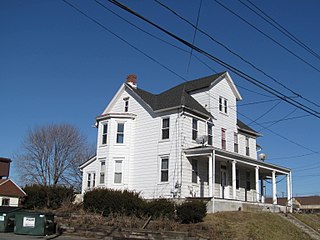Britain usually refers to the United Kingdom, a sovereign state comprising the island of Great Britain, the north-eastern part of the island of Ireland and many smaller islands.
Hume most commonly refers to:

Fertile is a city in Polk County, Minnesota, United States. It is part of the Grand Forks ND-MN Metropolitan Statistical Area. The population was 842 at the 2010 census.
Urban means "related to a city". In that sense, the term may refer to:

In law, an unincorporated area is a region of land that is not governed by a local municipal corporation; similarly an unincorporated community is a settlement that is not governed by its own local municipal corporation, but rather is administered as part of larger administrative divisions, such as a township, parish, borough, county, city, canton, state, province or country. Occasionally, municipalities dissolve or disincorporate, which may happen if they become fiscally insolvent, and services become the responsibility of a higher administration. Widespread unincorporated communities and areas are a distinguishing feature of the United States and Canada. In most other countries of the world, there are either no unincorporated areas at all, or these are very rare; typically remote, outlying, sparsely populated or uninhabited areas.
Earth is a planet in the Solar System, and the third planet from the Sun.
Content or contents may refer to:
Independence generally refers to the self-government of a nation, country, or state by its residents and population.

The limequat is a citrofortunella hybrid that is the result of a cross between the key lime and the kumquat, hybridized by Walter Tennyson Swingle in 1909.

Loam is soil composed mostly of sand, silt, and a smaller amount of clay. By weight, its mineral composition is about 40–40–20% concentration of sand–silt–clay, respectively. These proportions can vary to a degree, however, and result in different types of loam soils: sandy loam, silty loam, clay loam, sandy clay loam, silty clay loam, and loam. In the United States Department of Agriculture textural classification triangle, the only soil that is not predominantly sand, silt, or clay is called "loam". Loam soils generally contain more nutrients, moisture, and humus than sandy soils, have better drainage and infiltration of water and air than silt and clay-rich soils, and are easier to till than clay soils. The different types of loam soils each have slightly different characteristics, with some draining liquids more efficiently than others. The soil's texture, especially its ability to retain nutrients and water, are crucial. Loam soil is suitable for growing most plant varieties.
A weed is an unwanted plant of any species.

The New England town, generally referred to in New England simply as a town, is the basic unit of local government and local division of state authority in each of the six New England states and without a direct counterpart in most other U.S. states. New England towns overlay the entire area of a state, similar to civil townships in other states where they exist, but they are fully functioning municipal corporations, possessing powers similar to cities in other states. New Jersey's system of equally powerful townships, boroughs, towns, and cities is the system which is most similar to that of New England. New England towns are often governed by a town meeting legislative body. The great majority of municipal corporations in New England are based on the town model; statutory forms based on the concept of a compact populated place are uncommon, though they are prevalent elsewhere in the U.S. County government in New England states is typically weak at best, and in some states nonexistent. Connecticut, for example, has no county governments, nor does Rhode Island. Both of those states retain counties only as geographic subdivisions with no governmental authority, while Massachusetts has abolished eight of fourteen county governments so far. With few exceptions, counties serve mostly as dividing lines for the states' judicial systems.

Egypt is an unincorporated community and a census-designated place in Whitehall Township, Lehigh County, Pennsylvania, United States, about 7 miles (11 km) north of Allentown and 1 mile (1.6 km) west of Cementon. Egypt is located on Pennsylvania Route 329, just west of its intersection with Pennsylvania Route 145 at Eagle Point.

Richlands is a small unincorporated farming community in Greenbrier County, West Virginia, United States, five miles (8 km) west of Lewisburg on U.S. Route 60.
Little is a synonym for small size and may refer to:

Wellsville, Colorado is a small unincorporated community located on U.S. Highway 50 in western Fremont County, Colorado. The town straddles the banks of the Arkansas River and follows the highway before the road starts winding through tight curves into Chaffee County. Wellsville is the site of US Soil's processing facility, where it mines a natural fertilizer from an ancient lake bed.







